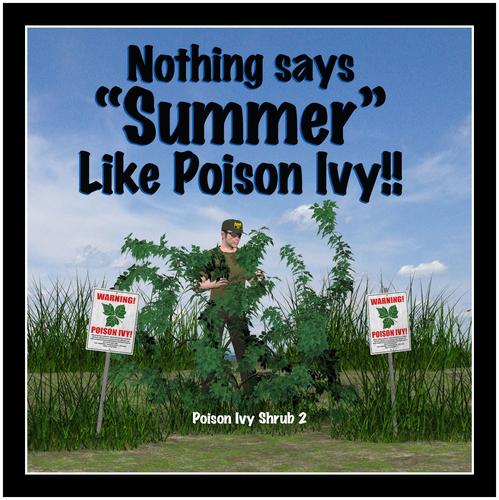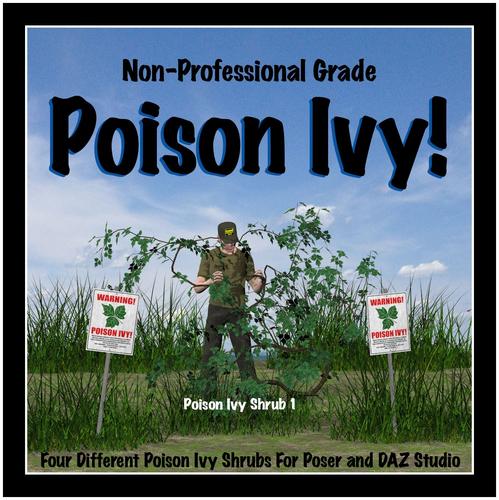Poison Ivy... The plant, not the character.
Poison Ivy
Get you free Poison Ivy here:
http://www.ShareCG.com/v/77548/view/11/Poser/Poison-Ivy
What you get in the Zip file:
4 Crappy Poison Ivy Shrubs, 1 Snarky Warning sign, a PNG sheet full of nasty blisters to place on your 3D character's texture maps (you'll need an image editor like GIMP or Photoshop for that)… and a biodegradable photon enriched Readme.
These plants were an experiment, they may or may not look okay close up… it depends on what you use them for.


PoisonIvyShrub4w.jpg
1355 x 1357 - 339K


PoisonIvyShrub3w.jpg
1355 x 1357 - 336K


PoisonIvyShrub2w.jpg
1355 x 1357 - 367K


PoisonIvyShrub1w.jpg
1355 x 1357 - 372K



Comments
FUN POISON IVY FACTS:
• Poison Ivy-(Toxicodendron radicans),is a poisonous North American and Asian flowering plant that is well known for causing an itching, irritating, and nasty festering painful rash in most people who touch it. The rash is caused by urushiol, a clear liquid compound in the sap of the plant.
• Goats can and will eat poison ivy with no ill effects.
• It is inadvisable to hug a goat who has consumed poison ivy, and is important that one reduce or limit their goat hugging during poison ivy season.
• Do not burn poison ivy leaves, especially if the poison ivy is growing up the side of your house. The smoke from the burning leaves can irritate your lungs and throat and the fire from the burning leaves can spread to the rest of your your house, or the polyester gorilla costume you happen to wear when gardening.
• The weeping (dripping) blister fluid can not spread the rash to someone else.
The only way to spread this rash from one person to another is by the transfer of the plant juice. The blister fluid generally does not contain the allergenic chemical so this is not likely to ever occur.
The best way to spread the rash to someone else is to wait for them to fall asleep naked and then rub the leaves all over their body… you should also be wearing gloves and maybe that gorilla gardening costume (if you have one), just in case they wake up… their initial freak-out will give you time to run away.
• Individuals allergic to Poison ivy can react to other members of closely related botanical groups.
The allergen present in this plant group is structurally similar enough to react to plant juices from other members of the family Anacardiaceae, like cashew nut oil, mango rind, certain Chinese lacquers, and the Giant Walking Sumatran Flytrap Plant's saliva.
• The fat old cranky wives tale that allergic individuals can be desensitized by eating the leaves of the plant is not only untrue it is also pretty stupid.
It is very difficult to desensitize an allergic individual to this family of chemicals and equivalent to saying one can become desensitized to fire by eating it.
• Poison ivy is more common in North America than when Europeans first arrived. The development of real estate adjacent to wild, undeveloped land has engendered "edge effects", enabling poison ivy to form vast, lush colonies in these areas.
• It is listed as a noxious weed in the US states of Minnesota and Michigan and in the Canadian province of Ontario. Noxious weeds (poisonous or irritating to the skin) are more dangerous than obnoxious weeds, like the Laughing Jerk Plant or the Pissing Daisy, which just like to humiliate and annoy their victims.
• A study by researchers at the University of Georgia found that poison ivy is particularly sensitive to CO2 levels, greatly benefiting from higher CO2 in the atmosphere. Poison ivy's growth and potency has already doubled since the 1960s, and it could double again once CO2 levels reach 560 ppm.
But don't let that concern you when you let your car idle unnecessarily or waste energy in other unnecessary ways… its all a myth.
• There are numerous subspecies and/or varieties of Poison Ivy which can be found growing in any of the following forms, all of which have woody stems:
-as a trailing vine that is 10–25 centimeters (3.9–9.8 in) tall
-as a free standing shrub up to 10-12 feet tall (in southern climates).
-as a climbing vine that grows on trees or some other support.
• The sooner you treat an area of suspected contact the better your chances of avoiding a reaction. If you are able to remove the oils, you have a better chance of escaping the effects… the most effective timeline is 5 - 15 minutes (6.167 - 8.77781 metric minutes). There are several commercially available soaps that will effectively remove the oil, but even hand sanitizer on a tissue will remove it in the event you are expecting to be around it (like during Nation Rolling Around In Poison Ivy Day).
Keep in mind that if attempting to wipe it away as opposed to washing it away, you must avoid contacting the material on the rag or tissue lest you spread it around or get it on your hands too.
• Blisters and rashes will often show up in areas that never touched the leaves or contacted the oils… I forget why, but a very boring dermatologist friend of mine once explained that while I was sleeping… Probably something about fatty tissue and blood flow… really, he talks very, very slowly and his voice is so low… he has literally bored two cats and a parakeet to death… the parakeet actually hung himself.
• The oils can transfer to other things, like goat fur or polyester gorilla costumes and remain active and dangerous for very long periods of time. It is best to wash clothing or pantomime animal costumes with a strong detergent, several times to ensure a good cleaning.
Industrial strength goat cleaners like "Doctor Bob's Industrial Strength Goat Cleaner" are recommended for removing urushiol (that nasty poison ivy oil) as well as urinestinol (the pee smelling stuff from the Pissing Daisy).
• The easiest way to avoid an allergic reaction to poison ivy is by wearing protective clothing, like gloves, long sleeves, pants or a pantomime gorilla costume, when gardening or spending time outdoors. In the very least, wear a barrier cream when naked hiking or gardening.
• For god sake LOOK before you start weed-whacking any bushes or shrubs… Doing this willy nilly, spreads a fine mist of urushiol ALL OVER EVERYTHING WITHIN A TEN FOOT RADIUS… or more, depending on potency, wind speed and direction.
If you want colorful, drippy and swollen skin I applaud your choice, but please don't share it with others… Like the idiot landscaper I saw weed-whacking a thick patch, right next to a group of preschoolers.
Sharing isn't always good.
• Most common effective treatment- Immediate washing with soap and water or rubbing alcohol may help prevent a reaction. During a reaction, Calamine lotion or diphenhydramine may help mitigate symptoms. Corticosteroids, either applied to the skin or taken by mouth, may be appropriate in extreme cases. An astringent containing aluminum acetate (such as Burow's Solution) is also found to provide relief and soothe the uncomfortable symptoms of the rash.
Have a wonderful rash-free day!
Thanks for this! Looks great!
And another fun fact - even during the winter/fall when the ivy has died back for the season, the oils are still potent. Coming into contact with it even in it's fallow period can still result in the reactions. =)
Which is why its always a good idea for one to wear their pantomime gorilla costume, even in the winter... especially if you intend to crush up said leaves and add them to your snow balls, for that added advantage in a heated snowball fight.
One of the big problems with poison ivy is that the oil tends to bond to skin, making it extremely difficult to just wash off. I've been using Tecnu for a number of years and it works quite well. (I have a LOT of poison ivy in my area!)
It's very important to wash and dry your area often, also helps prevent chafing.
I love your informative paragraphs and readmes :-)
This is an awesome post and item, many thanks!
I just love your posts!
Thanks for the warning about hugging those goats.
:) :) :) :) :)
Thank you for making my front yard complete. If anyone wants some R/L poison ivy, please contact me. I'm more than willing to share. In fact, you can have all of mine. Come and get it. I never had a reaction to this noxious weed until last year even though I've been around it for over half a century.
I had a friend who used to get it fro the air he was so sensitive to it. Had to use air filtration systems before they were popular.
I used to get every summer and the doctors suggested injections to help with it in season.
I also found out accidentally when I was a photographer that Glacial Acetic Acid found in fix and acid stop baths actually helped heal the blisters. In fact several years after discovering this and dipping y arms in big 16x20 chemical trays (which is not recommended if you have skin sensitivities or are planning to get them quickly) every season I got it, Some smart pharmaceutical company developed a kit that contained a little bottle of Glacial Acetic Acid and wood popsicle sticks. The idea was to scrape the pustules with the popsicle stick and then put the acid on the open sores. Actually helped dry them up quicker but it was cheaper for me to wade into my 16X20 trays when working in the dark room. I am just glad I never decided to have kids! LOL
Thanks for these. I've only 'had' poison ivy twice. Once from a walk in the woods in Connecticut and the other from an old German Shepherd I made friends with who obviously walked in the woods a lot.
Love your readme too! Another fun fact, most all plants are sensitive to and grow better with more CO2--even trees. That's why it's pumped into greenhouses. The plants (very very few of them) that are less sensitive came about by necessity during the last glaciation when CO2 dropped to within 20-30PPM of stopping photosynthesis entirely. Now that's a scary thought.